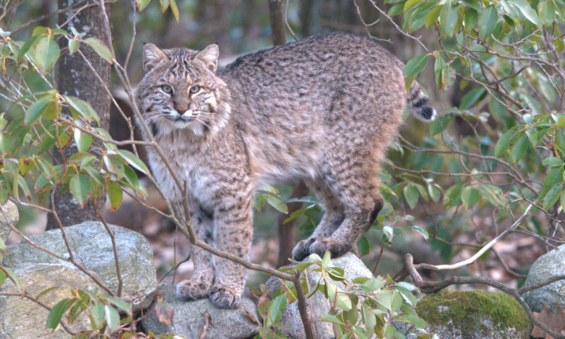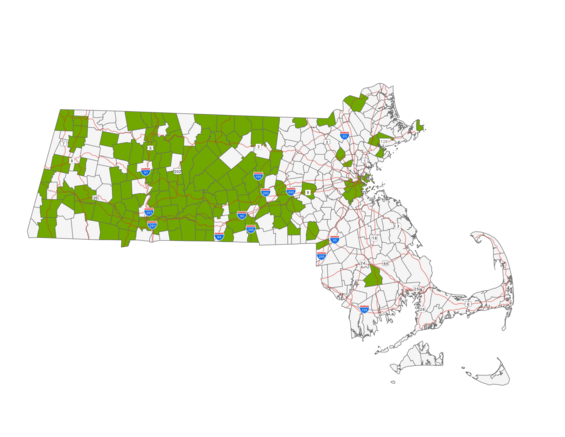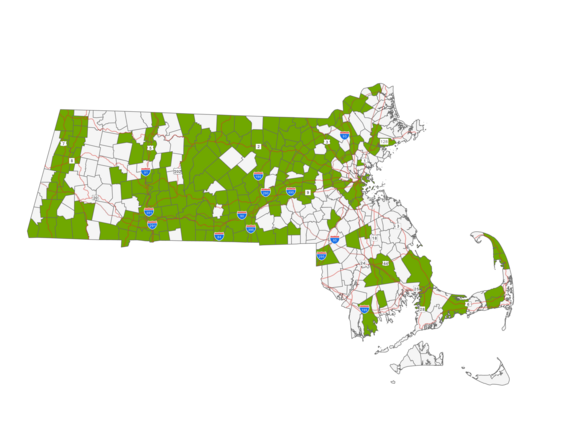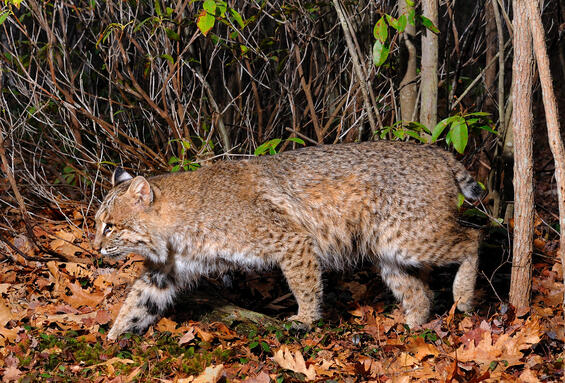- Scientific name: Lynx rufus
- Species of Greatest Conservation Need (MA State Wildlife Action Plan)
Description

Bobcat (Lynx rufus)
Bobcats are medium-sized feline carnivores with a short, “bobbed” tail (up to 30 cm [12 in]), slightly tufted ears, a prominent facial ruff, rather small head, and long legs relative to body length. They have short, dense fur occurring in a variety of color patterns, but typically yellowish or reddish brown with distinct or faint black spots along its flanks and white underparts that are also spotted with black. The tail has stripes or bands only on the upper surface. The feet have functional toes with sharp, retractile claws. Adult bobcats weigh 6–15 kg (15–35 lb) and measure 71–119 cm (28–47 in) in length. Size varies depending on sex, as male bobcats are approximately 33% larger than their female counterparts. Bobcats are the only wild cat currently found in Massachusetts.
Life cycle and behavior
Bobcats are solitary and generally elusive. Bobcats most commonly prey on medium-sized animals such as rabbits and hares but will eat mice, squirrels, skunks, opossums, muskrats, birds, and snakes. They will also consume small livestock. Occasionally bobcats will prey on larger animals, such as deer, but this is generally when other food items are scarce or the larger animal is sick, injured, young, or very old. When food is plentiful, they will cache the excess by covering it with leaves, grass, or snow and return to feed on it. Bobcats can be active day or night but tend to exhibit crepuscular (dawn and dusk) activity. Their activity peaks 3 hours before sunset until midnight and again between one hour before and four hours after sunrise. They remain active year-round and do not hibernate.
Bobcats breed from February through March. They are polygamous and do not form lasting pair bonds. Females produce one litter each year in April or May consisting of 1–4 kittens (2 on average). The kittens are born in a den located in rock crevices, under rocky ledges, in caves, in brush piles, or in hollow trees, stumps, or logs. Females may use the same den sites for several years. The young remain with the adult female until they are full grown, usually through their first fall or winter. Females reach sexual maturity at one year of age, although they do not typically produce their first litter until 2 years of age. Males do not reach sexual maturity until 2 years of age. Bobcats live an average of 12 years in the wild and females continue to produce one litter per year until death.

This graphic represents the peak timing of life events for bobcat in Massachusetts. Variation may occur across individuals and their range.
Population status
Bobcats are classified as a furbearer species, for which a management program and regulated hunting and trapping seasons have been established. MassWildlife does not currently estimate the bobcat population but monitors trends in harvest and bobcat reports.

Massachusetts towns with bobcat harvest reports. 2018/19-2022/23. Based on MassWildlife records.

Massachusetts towns with bobcat sightings and nuisance reports. 2015-winter 2025. Based on MassWildlife records.
Distribution and abundance
Bobcats are common in western, central, and northeastern Massachusetts, and reports are increasing in numbers in the southeastern counties. The abundance of rocky ledges for denning was once thought to be a limiting factor for their range, but with bobcats adapting to suburban environments, this may not hold true.
Habitat
Bobcats are well-adapted to a variety of habitats, such as mountainous areas with rocky ledges, hardwood forests, swamps, bogs, and brushy areas near fields. Typical bobcat habitat in western Massachusetts includes regenerating forest, small hardwood stands, and other early successional habitats. In winter, bobcats often select cliffs and dense stands of spruce or hemlock-hardwoods. Dense understory vegetation and rocky ledges are important structural components of bobcat habitat. They tend to prefer areas with dense cover supporting an abundance of medium-sized prey and allows for hunting by ambush or stalking. Bobcats deal with human influences but seem to avoid areas with extensive agriculturally cleared lands that eliminate other habitat types. Bobcats are adapting to suburban settings and may be seen in backyards and residential areas.
Healthy habitats are vital for supporting native wildlife and plants. Explore habitats and learn about conservation and restoration in Massachusetts.
Threats
Bobcats may be threatened by changes in habitat quantity and quality, human-induced mortality, interspecific competition, the impact of parasites and diseases, and secondary rodenticide poisoning. The key management needs for bobcat include the development and implementation of accurate survey or census techniques, protection or improvements of habitat for bobcat and prey species, refinements in harvest management to better match variations in abundance in space and time, improving public knowledge and support for management options, evaluating the effectiveness and need for federal oversight, and understanding and monitoring the impact of diseases and parasites on bobcats. Long-term studies are essential to most of these needs.
Conservation

Bobcat (Lynx rufus)
MassWildlife monitors changes to the distribution of bobcat harvest in the portions of the state where harvest is permitted. Public sightings are monitored throughout the Commonwealth, which helps to document the increasing presence of bobcats in eastern portions of the state. No other studies or monitoring projects are currently being conducted by MassWildlife. Current and recent bobcat research in Rhode Island, Connecticut, New Hampshire, and New York can help to inform the factors influencing bobcat populations in the region.
Habitat management including logging and burning helps to create and maintain bobcat habitat, as these activities support abundant prey species. Long-term studies, including collaring and tracking bobcats would be needed to determine causes of mortality, survival, and production of young in Massachusetts. Results from adjacent states can be informative for bobcats in Massachusetts as well, however differences in management and local conditions must be considered.
References
Anderson, E.M., and M.J. Lovallo. “Bobcat and lynx”. Pages 758-786 in G.A. 2003.
Feldhamer, B.C. Thompson, and J.A. Chapman (eds.) Wild Mammals of North America: Biology, Management, and Conservation, 2nd edition. Johns Hopkins University Press, Baltimore, Maryland, 2003.
Berendzen, S.L. “Ecology and status of the bobcat in western Massachusetts.” M.S. thesis, University of Massachusetts, Amherst, Massachusetts, (1985): 95pp.
Woolf, A., and G.F. Hubert, Jr. “Status and management of bobcats in the United States over three decades: 1970’s – 1990’s.” Wildlife Society Bulletin 26 (1998): 287-294.
For more information on bobcat from MassWildlife, see Learn about Bobcats.
Contact
| Date published: | May 1, 2025 |
|---|